Capturing Urban Splendor: Insights for Photographers

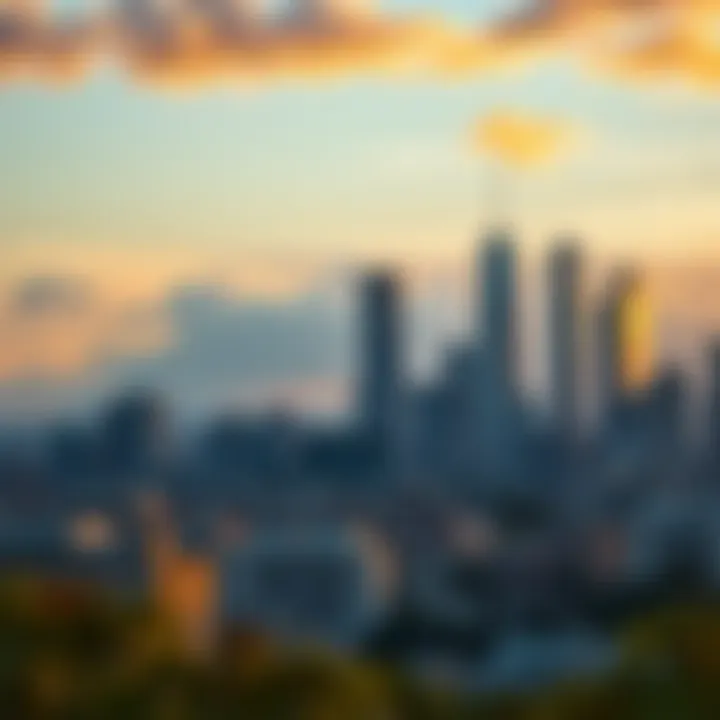
Intro
In the realm of urban photography, downtown views represent more than just cityscapes; they embody a narrative of life, culture, and identity. Capturing the heartbeat of a city through its architecture, bustling streets, and ambient light requires an astute understanding of both artistic and technical elements. Whether you are an aspiring photographer or a seasoned professional, the vibrant scenes that downtown areas offer can significantly enhance your portfolio or serve as a stunning backdrop for real estate presentations.
This article seeks to illuminate the intricacies of photographing downtown environments. We dive into vital aspects, such as perspective, light, and composition, which play pivotal roles in transforming a mere snapshot into a compelling visual story. Emphasizing practical advice, we will navigate through the nuances that can elevate your photography, gearing insights toward a diverse audience that includes investors, agents, and expatriates.
The urban landscape is more than just a physical space; it serves as a living canvas rich with stories waiting to be told. As we explore these downtown vistas, let’s unwind the thread of technical expertise and artistic sensibility, leading to breathtaking photographs that resonate with viewers.
Market Analysis
Understanding the market dynamics surrounding urban photography unveils a plethora of opportunities for photographers looking to carve their niche.
Current Trends and Insights
As urban environments continue to flourish, so does the demand for high-quality photography that encapsulates the essence of city life. Current trends indicate a shift toward authenticity in photography. Audiences are gravitating towards images that represent genuine experiences rather than polished, idealized versions of places. Here are a few key trends:
- Documentary Style: More photographers are adopting a documentary approach, focusing on the daily lives of city dwellers rather than just architectural highlights.
- Drones and Aerial Shots: The advent of drone technology has added a new dimension to urban photography, offering birds-eye views that capture the scale and scope of cities.
- Night Photography: The allure of city lights at night has sparked a rise in night photography courses, revealing how lighting can dramatically change the feel of a downtown scene.
These trends suggest that photographers who can harness the pulse of the city through engaging stories and unique perspectives will find success.
Future Projections and Opportunities
Looking ahead, the future of downtown photography appears bright. As cities evolve and expand, the need for capturing the essence of urban life will be paramount. Photographers can explore various niches, such as:
- Real Estate Photography: As urban areas develop, the demand for real estate imaging remains steady. Properties can be effectively marketed by showcasing the surrounding neighborhood’s vibe.
- Social Media Content: With the rise of platforms like Instagram and Facebook, there’s an increasing appetite for creative urban images that encourage engagement and sharing.
- Cultural Narratives: Cities are cultural melting pots, and opportunities lie in documenting festivals, community events, and local traditions that reflect the diversity of urban life.
By aligning with these trends, photographers can not only enhance their craft but also position themselves strategically in a competitive market.
The Essence of Downtown Views
Exploring the essence of downtown views is paramount for both photographers and urban enthusiasts. This urban aesthetic reflects a dynamic tapestry of human experience, cultural vibrancy, and architectural innovation. Capturing these views involves understanding more than just what catches the eye; it’s about conveying a sense of place—an identity that resonates with both locals and visitors.
By delving into the intricacies of downtown vistas, photographers can unlock the potential to tell stories that encapsulate the pulse of city life. From the rhythm of bustling streets to the tranquility found in the corners of urban parks, every element plays a part in composing an atmospheric scene.
The exploration of these perspectives can also be beneficial for investors and agents, who are often on the lookout for potential opportunities within urban areas. High-quality visual content that showcases the essence of a location can attract interest and investment.
Defining Urban Aesthetics
Urban aesthetics are defined by a unique blend of structure and spontaneity. The skyline, infused with history and contemporary design, serves as a landmark for potential discovery. Each building tells a story, whether through its height, material, or history.
- Color Palette: Urban environments present a rich color palette that shifts with the time of day, weather, and seasons. The sun setting behind glass skyscrapers paints the scene in amber hues, while a cloudy day might cloak the landscape in muted tones.
- Textures and Patterns: The determination of textures can bring depth to urban images. A contrast between the smoothness of steel and the roughness of brick can evoke contrasting emotions and narratives. Additionally, patterns found in architecture, bustling streets, and pedestrian interactions add to the overall charm of the aesthetic.
Making sense of urban aesthetics isn't only for artistic merit; it allows one to capture the spirit of a city, making it tangible in photographs. The interplay of elements creates a living tableau that photographers must learn to recognize and celebrate.
The Role of Skyline Perspectives
Skyline perspectives reveal the true nature of a city. They form the skyline's backbone, acting as a visual representation of urban life. From rooftops to piers, the varied vantage points provide context and drama to the photograph.
The skyline is more than just a backdrop; it’s a symbol of ambition and possibility.
- Elevated Views: Taking photographs from a higher elevation, such as a rooftop or hill, can elevate the visual experience, displaying a broad, sweeping view of the urban landscape. This perspective often enables the viewer to appreciate the arrangement of streets, buildings, and open spaces in conjunction with each other.
- Foreground Elements: Including foreground elements in skyline images can create a sense of depth. A tree with its sprawling branches or a busy café terrace can serve to juxtapose the immensity of the skyscrapers, embodying the everyday life that thrives below.
Photography Techniques for Urban Landscapes
Photography in urban settings presents a unique blend of opportunities and challenges. Mastering the techniques related to this discipline is crucial for anyone looking to capture the essence of downtown life effectively. With an intricate interplay of light, shadow, and architectural elements, urban photography enables storytellers to connect deeply with their audience. By focusing on essential techniques, photographers can elevate their visual narrative and inspire emotional responses.
Choosing the Right Equipment
When venturing into urban photography, the equipment you select can make all the difference. The right camera body does not necessarily have to mean the latest model; rather, it should suit your style and preferences. DSLRs or mirrorless cameras often provide the versatility needed for diverse shooting conditions. Consider these points:
- Lenses: A wide-angle lens is invaluable for capturing expansive cityscapes, whereas a telephoto lens can help isolate architectural details. For landscapes, a good standard lens like the 24-70mm can cover different scenarios well.
- Tripod: Stability is key, especially in low-light conditions. A sturdy tripod allows for longer exposure times without blurring, ensuring sharp images.
- Filters: Neutral density filters can aid in managing bright lights and allowing for longer exposures during daylight, enhancing movement in shots of bustling city streets.
By having the appropriate tools at your disposal, you lay the groundwork for capturing stunning images that resonate with urban life.
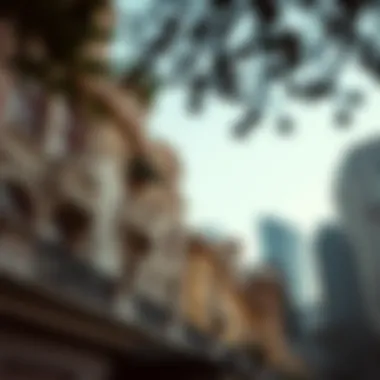
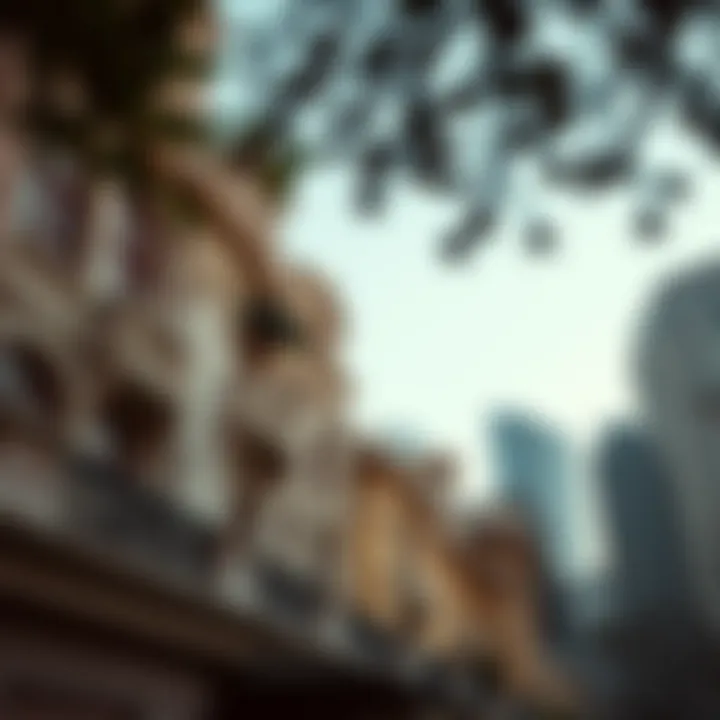
Understanding Lighting Conditions
Lighting can either make or break a photo, particularly in an urban context where reflections and varying light sources abound. It's essential to learn how to utilize different lighting conditions to your advantage:
- Golden Hour: This period, shortly after sunrise or before sunset, bathes the city in warm tones, softening shadows and adding depth to your photos. You might find that your morning shots come alive with a touch of golden glow.
- Night Photography: City lights can create beautiful, vibrant images. However, low light demands a good grasp of exposure settings. Increase your ISO to capture more light, but watch for noise that can detract from image quality.
- Artificial Light Sources: Street lamps, neon signs, and building lights can add character to urban night photography. Being mindful of the colors and types of artificial lights can enhance your composition.
Understanding how to manipulate and embrace various lighting scenarios will undoubtedly enhance the mood and atmosphere of your downtown images.
Utilizing Angles and Perspectives
The angle and perspective from which you approach a photograph can transform a simple shot into something spectacular. Here are factors to consider:
- Height: Explore shooting from elevations. Rooftops and higher vantage points can provide context and showcase the city layout, leading to intriguing compositions.
- Ground Level: Conversely, getting low can emphasize foreground elements, like interesting textures, while also making the background feel more prominent and expansive.
- Frames Within Frames: Using nearby elements like windows, bridges, and archways can create natural frames, drawing the viewer’s eye toward your focal point.
Experimenting with various angles allows you to discover unique perspectives that can differentiate your work from run-of-the-mill urban photography. Ultimately, be willing to step out of your comfort zone and explore what the city has to offer from different standpoints.
The Art of Composition
When it comes to photography, especially urban photography, composition plays a central role in determining the quality and impact of the image. It’s not merely about placing your subject within the frame; it’s about how each element interacts within that space to tell a story. A well-composed photograph brings clarity and purpose, attracting the viewer's attention and guiding their eyes to the intended focal points. This section explores poential strategies that can significantly enhance your downtown photography.
Rule of Thirds in Urban Photography
The Rule of Thirds is a fundamental technique that provides a simple yet effective guideline for composing striking photographs. Imagine breaking your frame into a grid of nine equal parts by drawing two equally spaced vertical lines and two equally spaced horizontal lines. By positioning your main subject along these lines or at their intersections, you create a naturally balanced image. This method invites the viewer's eye into the photograph rather than merely observing it from a distance.
For instance, if you are capturing a bustling street scene, you might place the horizon along the top third line while positioning interesting shop fronts or prominent architectural features along the vertical lines.
Benefits of Using the Rule of Thirds:
- Enhanced Visual Interest: It allows more dynamic interaction between elements.
- Simplified Eye Movement: This technique helps your audience navigate the image seamlessly.
- Engagement: By avoiding the center, you foster curiosity about what lies beyond the main subject.
However, don't feel constricted by this rule. Every great photographer knows when to adhere to guidelines and when to break them for artistic expression.
Incorporating Leading Lines
Leading lines are another powerful compositional tool that can direct viewers' attention and create depth in urban photography. These lines can be roads, sidewalks, building edges, or even the contours of nature interspersed between urban elements. They effectively lead the viewer’s gaze towards the focal point of your image or even provide a natural frame to isolate key elements.
When walking through downtown, keep an eye out for these naturally occurring linear elements. Have you spotted a sidewalk that seems to vanquish into the distance next to a stunning skyscraper? Capture that view to guide the audience into the heart of your scene. Not only do leading lines add a sense of perspective, they also draw viewers deeper into the narrative of your photograph.
"Incorporating leading lines in urban photography can transform a simple scene into a captivating story, making it not just an image, but an experience."
Practical Tips for Using Leading Lines:
- Look for converging elements that lead the eye towards a subject.
- Experiment with different angles to highlight various lines in the scene.
- Use wider apertures to blur distracting backgrounds, emphasizing the leading line effect.
Incorporating these techniques not only elevates your shooting ability but also ensures your audience connects emotionally with what they see. Mastery of composition in urban photography requires practice and a keen eye, but with patience and exploration, you can capture stunning downtown views that resonate with viewers on a profound level.
Storytelling Through Urban Photography
Urban photography transcends mere documentation of cityscapes; it is about weaving narratives through visuals that encapsulate the spirit of a place. The critical element of storytelling in urban photography elevates images from simple snapshots to profound reflections of life, culture, and history. The interplay between the subject matter and the photographer's intention creates a dialogue that speaks not only to the eyes but also to the heart. One could argue that every photograph tells a story, but when it comes to urban settings, the narrative becomes richer and more complex, drawing in viewers on multiple levels.
Capturing the City’s Essence
To genuinely capture a city's essence, photographers must go beyond iconic landmarks and invest time in the subtler aspects of urban life. It could be the bustling market scene on a Saturday morning or an elderly couple sharing a quiet moment on a park bench. Each sight provides a glimpse into the collective soul of the community. Here are some tips to aid in capturing that essence:
- Explore Varied Neighborhoods: Each area possesses its own character. Whether it's the artistic vibe of a historic district or the vibrant energy of a commercial hub, these neighborhoods tell distinct stories.
- Observe Local Culture: Holidays, street fairs, and cultural festivals offer vibrant backdrops. Capturing these events allows for images that resonate with authenticity and emotion.
- Focus on Details: Sometimes, it's not the vast cityscape that tells a story, but the small moments—a child playing, a busker strumming a guitar, a freshly painted mural. Look for ways to tell a story through details.
Using these techniques, photographers can create a body of work that portrays not just the physical features of a city but the emotional experiences tied to those scenes.
The Importance of Emotion in Imagery
Emotion serves as the connective tissue of visual storytelling. When a photograph stirs feelings—be it nostalgia, joy, or melancholy—it resonates more deeply with the viewer. Emotion fuels the narrative and compels the audience to look closer.
- Evocative Subjects: Including people in urban scenes often amplifies emotional impact. Candid shots of pedestrians lost in thought, children laughing, or artists at work can convey a narrative that resonates powerfully with viewers.
- Use of Color and Light: The way light interacts with a scene can dramatically influence emotion. Warm golden hours create a sense of tranquility, while stark shadows might evoke moments of conflict or tension. Experimenting with color grading in post-processing can amplify this effect—warmer tones might create a cozy feeling, while cooler hues can suggest isolation.
- Capturing Movement: Long exposures can illustrate the hustle and bustle of city life, lending a sense of vibrancy to the still image. Conversely, freezing action can depict a moment of isolation amidst the chaos, highlighting the contrast between collective activity and individual experience.
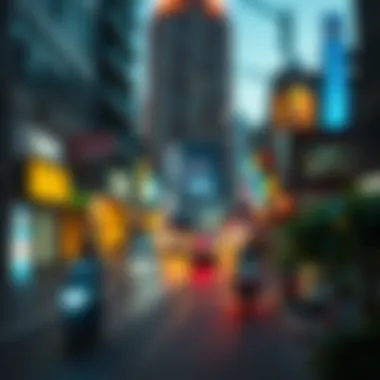
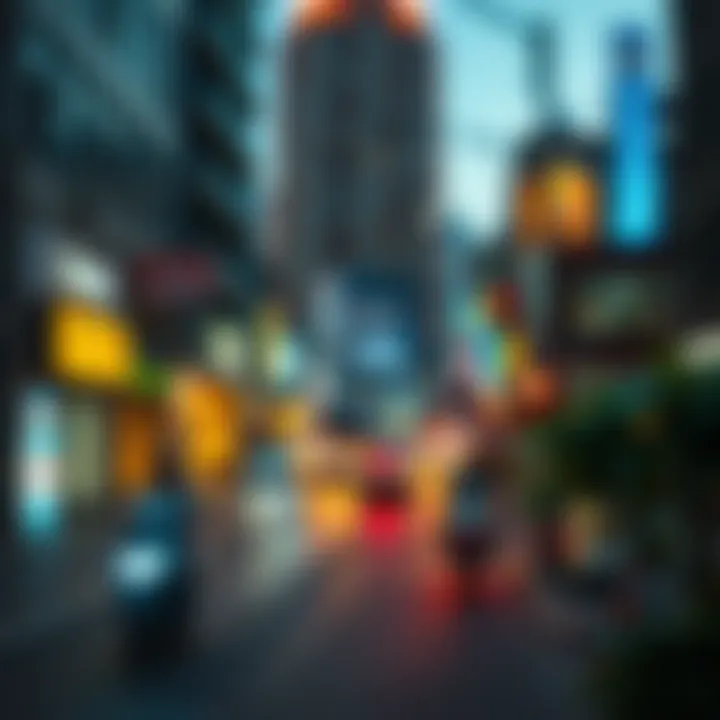
In essence, emotion in urban photography transforms a simple image into a compelling story. Each photograph can ignite curiosity and invite viewers to explore the narrative behind the frame.
"The photographs that speak the loudest are often the quietest ones, whispering stories that words can't capture."
In the end, mastering storytelling in urban photography is about connecting with your subject matter on a deeper level. By focusing on the essence of the city and harnessing emotional resonance, photographers can create poignant narratives that linger long after the viewer has stepped away.
Post-Processing in Urban Photography
In the dynamic realm of urban photography, post-processing stands as a crucial step that can transform a decent shot into a truly captivating image. It’s more than just tidying up; it’s about enhancing the story you want to convey through your photographs. This phase allows photographers to tweak aspects of their images that might not fully reflect their intended vision. Whether it’s to emphasize the vibrant life of a bustling street or to soften the sharpness of a harsh skyline, editing can play a pivotal role. It can attract investors, real estate agents, and expatriates alike, making avenues visually appealing and market-ready.
Post-processing facilitates not only aesthetic enhancement but also creative expression. By manipulating elements like exposure, colors, and contrast, photographers can elicit specific emotions. It’s apt to say that a photograph is like a canvas; post-processing helps paint a compelling picture from what was initially captured. This makes a photographer’s skill in editing just as essential as their ability to click the shutter.
Editing Techniques for Impactful Images
When delving into editing techniques, a few key strategies can be especially impactful in urban photography. These practices serve to refine images and assert the photographer’s narrative:
- Cropping and Framing: Often, what isn't in the frame can be as important as what is. Cropping can help focus the viewer’s attention on the subject while removing distractions. A well-framed image can bring the essence of city life into sharp relief.
- Sharpening Details: Enhancing sharpness can make architectural lines stand out and give clarity to focal points. This technique draws the viewer's eye directly to significant elements, like the texture of the buildings or the hustle of pedestrians.
- Layering Elements: Many editing software applications allow you to layer different elements of your photo. This is useful in urban environments where you can juxtapose light and dark areas, adding depth to your images.
- Dodge and Burn: Traditional darkroom techniques of dodging and burning can now be accomplished digitally, allowing specific areas of your photo to be highlighted or shaded, creating a more dynamic image.
Adopting these editing techniques not only improves overall image quality but can also make each photograph stand out in a crowded marketplace.
Balancing Colors and Contrasts
Color and contrast in urban photography is akin to seasoning in cooking; too little and the dish may fall flat, too much and it might become overwhelming. Striking the right balance can greatly enhance the visual appeal of a photograph.
In vibrant city settings, careful consideration of colors can evoke emotions and set the tone. Here’s how:
- Color Grading: Through color grading, photographers can enhance the mood of the image. For instance, a sepia tone could evoke nostalgia, while vibrancy might reflect the energetic pulse of a city.
- Contrast Adjustment: Low contrast can result in flat photos, while high contrast might obliterate nuances. Adjusting levels wisely can highlight textures and details without losing essential parts of the image. This means ensuring the distinctions among elements are clear but not jarring.
- Use of Complementary Colors: When focusing on elements like sunsets against city skylines, emphasize complementary colors that can create visual harmony. The warm hues of a setting sun juxtaposed with cool blues of steel structures can be mesmerizing.
- Histogram Monitoring: Keeping an eye on the histogram while editing helps ensure that colors are balanced well. A well-distributed histogram signals that there are no significant losses of detail in shadows or highlights.
Mastering the balance of colors and contrasts can elevate urban images beyond mere snapshots, allowing them to resonate with viewers on a deeper level.
"A picture is worth a thousand words, but a well-edited photograph can tell a story that lingers long after it’s been seen."
By understanding and implementing these post-processing strategies, photographers can harness the full potential of their urban photographs, ensuring that each image is not just seen but felt.
The Role of Social Media in Urban Photography
In today's interconnected world, social media serves as a powerful platform for urban photographers. Its significance cannot be underestimated, especially for those capturing the essence of downtown views. Through various channels like Instagram, Facebook, and Pinterest, photographers can showcase their artistry, connect with like-minded individuals, and expand their reach. With just a post or a story, a mundane cityscape can garner attention, inspire dialogue, and foster a community of enthusiasts who appreciate the complexities of urban photography.
Building Your Visual Portfolio
Creating a visual portfolio on social media is not just about sharing photos; it is about telling a compelling story. Each image becomes a thread in the fabric of your artistic narrative. Start by curating your best works, focusing on quality over quantity.
- Highlight Your Best Shots: Don’t overwhelm your audience; pick photographs that demonstrate your style and skills. Each post should reflect a conscious choice.
- Diversity: Incorporate various downtown settings—skylines, street life, or architectural details. Variety keeps your audience engaged and shows your versatility.
- Consistency in Style: Utilize a consistent aesthetic through your editing techniques and color palettes. This creates a recognizable brand that resonates more deeply with viewers.
Social media also allows the flexibility to adapt quickly. For instance, if a specific type of image—like twilight cityscapes—draws more engagement, you can pivot your content strategy accordingly.
Engaging with a Broader Audience
The potential to engage a broader audience is where social media truly shines. Here are essential strategies to amplify your reach:
- Utilize Hashtags Wisely: Effective hashtags can increase your visibility significantly. Consider using location tags, photography-specific tags, or even trending tags relevant to your work.
- Collaborations: Partner with other photographers or local businesses. This can introduce your work to their followers, providing cross-promotion that benefits all involved.
- Engage and Interact: Respond to comments and messages. Engagement isn’t just about posting; it’s about fostering a community. You never know when a simple reply can lead to a new opportunity.
By weaving these practices into your social media strategy, you can not only showcase your photography but also participate in ongoing conversations about urban life.
In summary, social media is an invaluable tool for urban photographers. It allows for portfolio building and wider audience engagement, essential for anyone looking to leave their imprint in the lively realm of urban photography.
"In the age of technology, authenticity resonates—be genuine in your photography and your audience will find you."
Find more about effective social media strategies here: https://www.thoughtco.com/social-media-tips-for-photographers-2693118
Explore urban photography communities on reddit.com/r/photography for inspiration and guidance.
Timelessness of Downtown Views
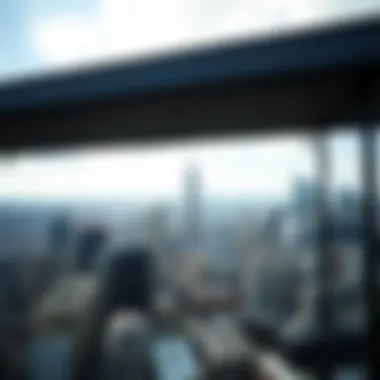
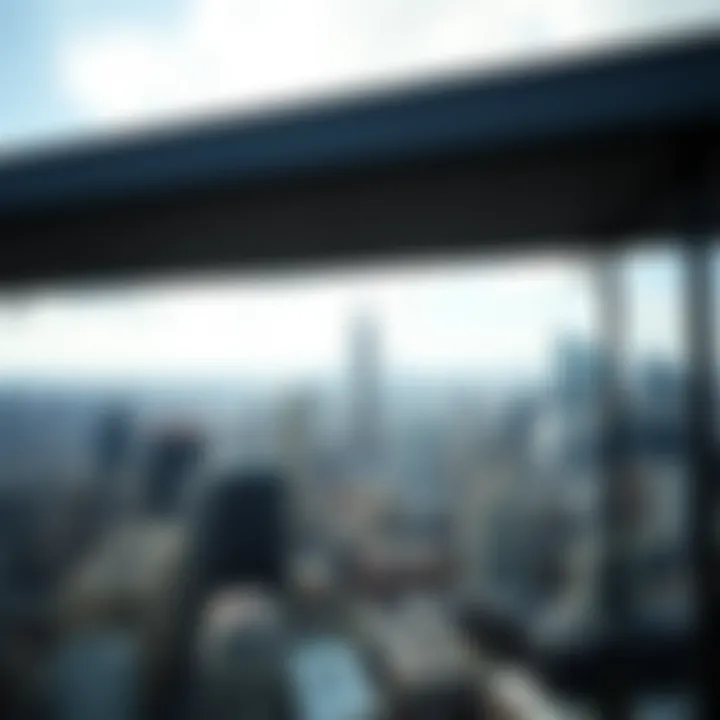
Capturing the essence of city life through photography often transcends time. The timelessness of downtown views captures both the ever-present pulse of urban culture and the subtle shifts that occur over time. As we explore this facet, it's crucial to consider how historical contexts and evolving trends in cityscapes shape our visual storytelling.
Historical Contexts in Urban Photography
The relationship between photography and history is like a well-fitted puzzle piece. When delving into urban photography, understanding the historical backdrop brings depth to each shot. Cities often tell stories through their architecture, infrastructure, and even the people who inhabit them. For instance, a photograph of an old building may serve as a relic of a bygone era, reflecting styles reminiscent of its time, yet still stands proudly amongst the contemporary plateaus of glass and steel.
Consider the old brick warehouses of Brooklyn, juxtaposed with sleek high-rises. This contrast symbolizes a narrative, depicting how urban environments morph—and yet how segments of their heritage stick around, whispering stories of the past. Photography ain't just about angles and lighting; it’s about capturing these narratives that enrich the images.
The buildings, streets, and squares are full of tales waiting to be told. Here’s where those historical contexts breathe life into our urban captures:
- Cultural Significance: Each neighborhood has its unique flavor. Recognizing the historical significance behind specific locations adds layers to your photographs.
- Evolution of Styles: Observing changes in architectural styles over decades provides insight into societal evolution—like how Art Deco buildings evoke the Great Gatsby era or modernist structures shout minimalism.
- Celebrating Resilience: Cities endure through economic upheavals, natural disasters, and social change. When documented, these reflections illustrate the unyielding spirit of urban spaces.
"Photography is the story I fail to put into words." - Destin Sparks
This notion is particularly true in urban photography where every snapshot has the potential to tell a story far greater than itself.
Evolving Trends in Cityscapes
As we bring our cameras to the urban environment, it's essential to stay attuned to the evolving trends in cityscapes. What worked a decade ago may not resonate with the contemporary viewer. Key shifts in style and approach can redefine how we capture downtown views. Here are some trends worth noting:
- Sustainability in Architecture: The rising emphasis on eco-friendly buildings is notable. Images of green rooftops or urban gardens not only capture modernity but also a shift toward sustainability—a narrative that many find appealing.
- Tech-Connected Environments: Smart cities equipped with digital displays and interactive designs change how urban landscapes are visualized. Representing these elements can create a dialogue about technology’s role in our lives.
- Street Photography Revival: Recently, street photography has regained momentum. Images showcasing everyday life, unpolished yet authentic, are gaining traction. They can highlight genuine interactions and the human experience amid the hustle and bustle.
A comprehensive understanding of these dynamics enhances the photographer's ability to convey a sense of place while also elevating their imagery from mere documentation to artistic expression. As one captures the pulse of the city through their lens, they contribute to the timeless narrative that continues to unfold, layer by captivating layer.
Advice for Amateur Photographers
Gaining a foothold in the world of photography, especially for downtown views, can feel like stepping into a maze with no clear map. Despite that, the journey can be as enriching as the destination itself. For amateurs, understanding the landscape involves more than just technical skills; it's also about cultivating a sense of observation, tapping into personal emotions, and ultimately discovering a unique artistic voice.
Overcoming Common Challenges
When diving into urban photography, many novice photographers stumble upon various roadblocks. Here are some common challenges faced along the way:
- Time of Day: The hustle and bustle of a city can make it tricky to capture the perfect moment. Often, the golden hour just doesn’t sync with a busy schedule, leaving the photographer grappling with harsh midday sunlight or muted evening hues. To combat this, consider scouting locations during your free time. This way, you’ll be ready when the lighting aligns.
- Crowded Spaces: When photographing popular city hotspots, people can easily photobomb your shot. Instead of fighting against the tide, embrace it. Sometimes, including people can add a narrative thread to your images. Alternatively, visiting lesser-known spots may yield tranquil moments free from distractions.
- Equipment Limitations: Not every amateur possesses an arsenal of high-end gear. But worry not! A basic camera or even a smartphone can still capture stunning downtown moments. Experimenting with angles, utilizing editing apps, and focusing on composition can elevate simple shots into captivating visuals.
"The best camera is the one you have with you." – Chase Jarvis
Embracing these challenges helps to deepen your understanding and appreciation of urban photography. It’s all about trying out new techniques, learning from missteps, and continually evolving your skillset.
Developing a Unique Style
Finding a personal style is where true artistry blooms. Instead of merely imitating other photographers, think about what your own artistic vision looks like. Here are key points to consider:
- Personal Themes: Explore topics in your environment that resonate with you. This might be the juxtaposition of historical buildings against modern skyscrapers or the vibrant street art that reflects community narratives. The more authentic the story, the more powerful the image.
- Color Palettes: Notice the colors that attract your eye. Perhaps you’re drawn to melancholic hues of gray and blue, or maybe the warm glow of sunset oranges. Consistency in color can become a hallmark of your style, creating a recognizable signature.
- Storytelling Approach: Every city has a story to tell. Think about how your perspective can reshape the narrative. Are you documenting hardship, vibrance, or the mundane beauty of everyday city life? Take your camera and allow it to capture the layers of urban existence.
In time, as you go on this artistic journey, your work will reflect your vision and personality, setting you apart from the crowd. Take every opportunity you can to shoot, experiment, and refine your craft, enabling your unique voice to emerge within the rich tapestry of downtown photography.
Culmination: The Future of Downtown Photography
As urban environments continue to evolve, the photography that captures their essence must also adapt. The need for fresh perspectives, innovative techniques, and a responsiveness to the changing landscapes is paramount. Understanding the future of downtown photography means acknowledging both the shifts in the physical space and the technological advancements that accompany them.
Embracing Change in Urban Landscapes
Urban landscapes are not static; they transform in ways that reflect societal changes, economic conditions, and cultural trends. As new buildings rise and older ones are repurposed or demolished, photographers must be ready to adapt their vision. There’s a certain beauty in capturing a city at different stages of its lifecycle. For example, when a historic building is slated for redevelopment, it becomes imperative to document its architectural details before it vanishes completely. Capturing these moments creates a narrative that speaks to the history and future of the urban environment.
Photographers can benefit by following several key approaches:
- Seek out the unseen: Explore parts of the city that others might overlook. Hidden alleyways, less frequented neighborhoods, and concealed artwork can provide unique perspectives.
- Collaborate with local communities: Engaging with residents can yield insights into the heart of the city, uncovering stories that might not be visible at first glance.
- Be versatile in your methods: With the rise of mobile photography, it’s essential to be nimble, allowing for quick shots as circumstances change.
Evolving Technology and Its Impact
Technological advancements are reshaping the world of urban photography. From the proliferation of drones to the capabilities of smartphones, the tools available to photographers have drastically grown. This evolution impacts not only how we capture images but also how these images are shared and experienced.
- Drones: These aerial devices can offer breathtaking shots of downtown skylines, giving a new perspective that was previously unattainable. Now, images that showcase the symbiotic relationship between buildings and the natural landscape become easier to obtain.
- Smartphone technology: With advancements in mobile phone cameras, striking images that encapsulate city life are being captured not just by professional photographers but by everyday individuals. This democratization of photography allows for a broader array of urban narratives.
- Digital editing tools: Software like Adobe Lightroom and Photoshop allows photographers to manipulate and enhance their shots, enabling compeling storytelling even after the shutter has clicked.
Embracing these tools means staying ahead of the curve and exploring new forms of artistic expression within the urban landscape.
"The photographer’s job is to observe the world with a discerning eye, one that notices not just what is present, but also what is changing right before us."
For more insights into the evolving nature of urban photography, consider exploring resources like Wikipedia, Britannica, or even engaging discussions on platforms such as Reddit.
Not only does this keep you informed of trends and techniques, but it also connects you to a community of photographers who are navigating the same challenges as you are.











